The Crux of the Matter: The Truths and Fictions of Crucifixions
How did Roman crucifixions work? And did medieval artists depict the Crucifixion accurately? An ancient historian and a medievalist combine forces to shed their light on matters of the cross.
Few events in history have left a more significant mark on collective imagination than the crucifixion of Jesus of Nazareth. For centuries, the most famous execution in the world has been depicted by hundreds of artists, and their representations of the episode, and its aftermath, can be seen in museums all over the world. Depictions of the crucified Christ occur in a wide variety of mediums and styles, but most of them share a striking similarity: they prominently feature wounds on Jesus’ hands, where he was supposedly nailed to the cross.
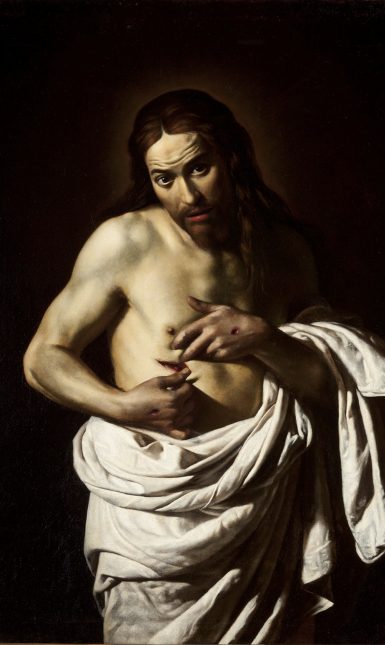

Crucifixion: the historical background
As potent and strikingly gruesome as these images may be to the modern observer, they are also very likely ahistorical – although the error is not in the assumption that the Roman authorities would have used crucifixion as a punishment in the early decades of the first century CE. Indeed, the practice was not uncommon in the ancient world, and appears to have been seen as a warning for potential evildoers due to its drawn-out and highly public character.[1] The victim could remain alive for multiple days before dying, and there is some indication that crucifixion was considered brutal and humiliating even by the standards of the day. For this reason, it was usually reserved for those who were believed to have committed particularly heinous crimes, like pirates, enemies of the state, and rebels. Furthermore, crucifixion was traditionally seen as a punishment for slaves, and was as such used during the famous Spartacus revolt of 71 BCE. Members of the higher classes, however, generally appear to have been exempt.[2]
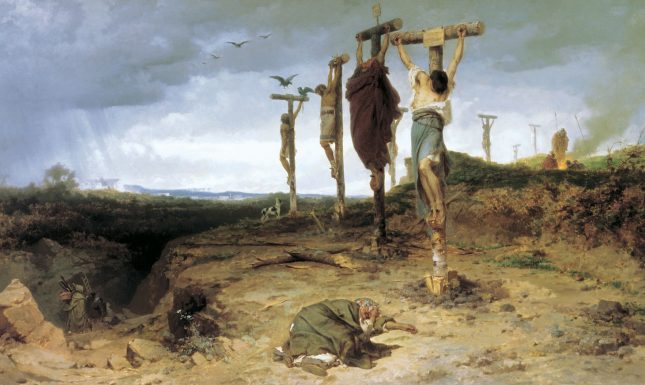

In itself, then, it is not unlikely that a person like Jesus, who was accused of attempting to stoke up rebellion against Roman rule by allegedly declaring himself king, would have been condemned to a death on the cross. However, the practical implications of his crucifixion are rarely accurately depicted in artistic representations of the event. Most notably, the common assumption that crucifixion involved the piercing of the palms with nails has come to be seen as implausible.
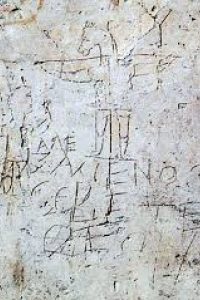

It is widely considered unlikely that the hands would be able to support the victim’s weight, especially without any additional support to either arms or legs. For this reason, it has been suggested that the nail would have instead pierced the victim’s wrists or forearms – both of which account for the use of the Greek world cheir in the description of Jesus’ wounds in the gospel of John, which is commonly translated as ‘hand’, but could likely include parts of the arm as well.[3]
Interestingly, however, the rare archaeological finds related to crucifixion may point in yet another direction. In 1968, a skeleton was found near Jerusalem with a single nail embedded in its heelbone. While it was initially believed that the skeleton’s arms showed crucifixion-related injuries as well, it was later argued that the damage to the bones was post-mortem, and that the victim’s arms had therefore likely been tied to the cross, rather than nailed. A more recent find from northern Italy showed similar, although not identical, damage to the heels, while clear evidence for crucifixion-related injuries to the arms was once again notably absent. Although different reconstructions have been suggested, it thus seems very likely that the traditional image of crucifixion does not stand up to closer scrutiny.
Video footage of the heel bone of a crucified man (now in the Israel Museum, Jerusalem) alongside two possible reconstructions, the latter of which represents more recent insights. Video via Associated Press Archive.Crucifixion: medieval artistic representations
So, why have artists throughout history depict the Crucifixion inaccurately? Lack of knowledge aside, there have been specific reasons why artists chose to imagine the Crucifixion in a way not conforming with historical reality. The medieval period is a good example to illustrate this point. Medieval artists found the effect of the image on the beholder more important than historical accuracy. To understand this better, we need to take a closer look at the context of medieval devotional practices. A key notion is that of ‘affective piety’, a type of devotion in the high and late medieval Latin West that emphasized Christ’s humanity and his suffering on the cross and foregrounded the emotions and imagination. Meditational texts and images encouraged devotees to imagine themselves present in the Passion narrative as eye-witnesses, evoking feelings of compassion.
A good example of an artwork inciting compassion is the Isenheim Altarpiece, painted by Matthias Grünewald for a hospital in which Antonine monks cared for the sick and dying. The gruesome depiction of the sickly, distorted body of Christ with spots of pox encouraged the patients to identify with the suffering Son of God. The uncomfortable position of the head and the crown of thorns piercing Jesus’ flesh are elements also found in late medieval passion meditations, aimed at inciting compassion:
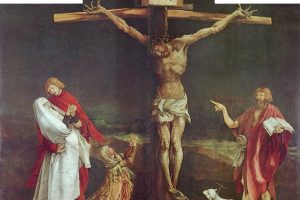

Meditations on the life and Passion of Jesus are crucial to understanding medieval depictions of the Crucifixion. In the widely read Meditationes vitae Christi (Meditations on the Life of Christ), the Crucifixion scene starts with ladders that are ascended by both Christ and his ‘evil-doers’. Then, “when He reaches the cross, at the upper part of this small ladder, he turns himself around, opens those royal arms, and, extending his most beautiful hands, stretches them up to his crucifiers.”[5] His arms are affixed to the cross with nails and another nail is driven through his feet. At this point, the author does not proceed but goes back to the beginning, presenting an alternative version:
This passage shows that more than historical accuracy, the effect of the description on the reader counted. At the beginning of the Meditationes, the author announces: “For the sake of greater impressiveness I shall tell [all things said and done by him] to you as they occurred or as they might have occurred according to the devout belief of the imagination and the varying interpretation of the mind.”[7] With help of the imagination, the reader could create a biblical landscape with images of the life and Passion of Christ. This landscape did not need to be historically accurate, but impressive and suited to one’s own experience.
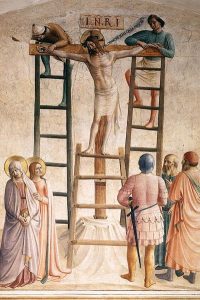
Of the two versions of the Crucifixion described in the Meditationes, the Franciscan Order favoured Christ climbing the cross himself. The reason for this preference was not the assumed historical accuracy of the scene; the Franciscans saw in Christ’s ascent of the ladder a sign of his willingness to sacrifice himself. Such theological and symbolic interpretations were common in the medieval period and also played a role when it came to the nails used to crucify Christ. The New Testament does not state clearly whether Christ was affixed to the cross with nails or ropes, but only nails could produce the flow of redemptive blood that washes away sins, theologians argued.[8] The two Thieves crucified alongside Jesus were usually attached to the cross with ropes in medieval images, emphasizing Christ’s singularity. Up to the twelfth century, artists depicted the Crucifixion with four nails, following the tradition of the Church Fathers. From c. 1150 we find, in the Latin West, also images in which Christ is nailed to the cross with only three nails: one for each hand, and one piercing both feet.[9] The Crucifixion with three nails has been interpreted in the light of the symbolic and theological meaning of the number three within Christianity. Moreover, the desire to emotionally affect the beholder could have been a motivation behind this iconography: the crossed legs or feet make Christ’s body look more sagging and tortured.
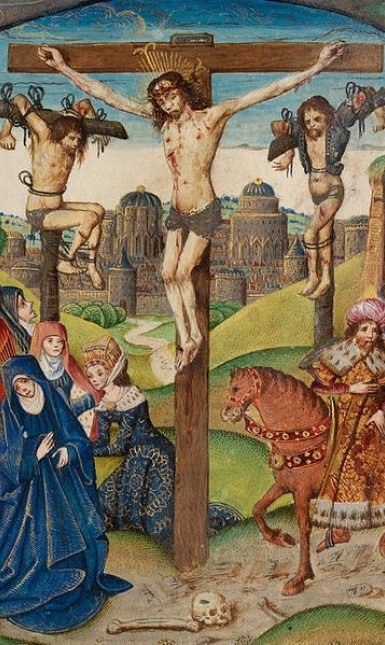

Thus, while archeological evidence might point towards ancient crucifixion methods without nails, medieval artists had their reasons for depicting the crucifixion the way they did, aiming to incite an affective religious experience and communicate theological doctrines.
Notes
[1] Donald G. Kyle, Spectacles of Death in Ancient Rome (Routledge: London, 1998), 53-55.
[2] For an elaborate discussion of the practice of crucifixion in the ancient world, see John Granger Cook, Crucifxion in the Mediterranean World (Mohr Siebeck: Tübingen, 2014). For its Roman legal context, see especially pages 358-416.
[3] A recent medical analysis of this issue and other questions related to crucifixion, with somewhat graphic imagery, may be found in Stephen Bordes, Skyler Jenkins, Lexian McBain, et all., ‘The Clinical Anatomy of Crucifixion’, Clinical Anatomy (15 April 2019).
[4] Quoted in James H. Marrow, Passion Iconography in Northern European Art of the Late Middle Ages and Early Renaissance: A Study of the Transformation of Sacred Metaphor into Descriptive Narrative (Van Ghemmert: Kortijk, 1979), 168.
[5] Meditationes vitae Christi (MVC), transl. Isa Ragusa, Meditations on the life of Christ : an illustrated manuscript of the fourteenth century, Paris, Bibliothèque nationale, MS. Ital. 115 (Princeton: Princeton University Press, 1977), 333-334.
[6] MVC, transl. Ragusa, 334.
[7] MVC, transl. Ragusa, 5.
[8] Mitchell B. Merback, The Thief, the Cross and the Wheel : Pain and the Spectacle of Punishment in Medieval and Renaissance Europe (London: Reaktion Books, 1999), 78.
[9] Gérard Cames, ‘Recherches sur les origins du crucifix a trois clous’, Cahiers archéologiques: Fin de l’antiquité et moyen âge 16 (1966), 185-202.
© Renske Janssen, Lieke Smits and Leiden Arts in Society Blog, 2019. Unauthorised use and/or duplication of this material without express and written permission from this site’s author and/or owner is strictly prohibited. Excerpts and links may be used, provided that full and clear credit is given to Renske Janssen, Lieke Smits and Leiden Arts in Society Blog with appropriate and specific direction to the original content.




0 Comments